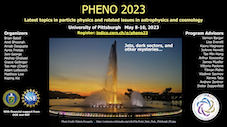Conveners
Tools I
- Lisa Benato (Hamburg University (DE))
I introduce a new method for calculating the dark matter (DM) scattering rate in a directionally sensitive detector, which for the most complicated analyses can be multiple orders of magnitude faster than previous approaches. The new method projects each ingredient of the rate calculation, such as the DM velocity distribution, onto a basis of orthogonal functions. This reduces the rate...
The hadronization process plays a crucial role in Monte Carlo event generators, where quarks and gluons are combined into observable hadrons. However, while current phenomenological models have been quite successful overall in simulating this process, there remain phenomenological areas where they still lack accuracy in describing the underlying physics. Recent research has taken a new...
We revisit the combinatorial problem at the LHC, taking $t\bar{t}$ production as an example. The combinatorial ambiguity in this case can be reformulated in terms of a quadratic unconstrained binary optimization problem. Finding the solution to the combinatorial problem becomes equivalent to finding the ground state of the Ising Hamiltonian. We explore several variational quantum algorithms to...
We present a decision tree-based implementation of autoencoder anomaly detection. A novel algorithm is presented in which a forest of decision trees is trained only on background and used as an anomaly detector. The fwX platform is used to deploy the trained autoencoder on FPGAs within the latency and resource constraints demanded by level 1 trigger systems. Results are presented with two...
Theory predictions for the LHC require precise numerical phase-space integration and generation of unweighted events. We combine machine-learned multi-channel weights with a normalizing flow for importance sampling, to improve classical methods for numerical integration. We develop an efficient bi-directional setup based on an invertible network, combining online and buffered training for...
Choosing which properties of the data to use as input to multivariate decision algorithms -- a.k.a. feature selection -- is an important step in solving any problem with machine learning. While there is a clear trend towards training sophisticated deep networks on large numbers of relatively unprocessed inputs (so-called automated feature engineering), for many tasks in physics, sets of...
Measuring the density profile of dark matter in the Solar neighbourhood has important implications for both dark matter theory and experiment. In this work, we apply autoregressive flows to stars from a realistic simulation of a Milky Way-type galaxy to learn – in an unsupervised way – the stellar phase space density and its derivatives. With these as inputs, and under the assumption of...
